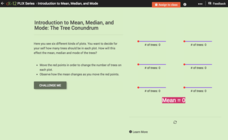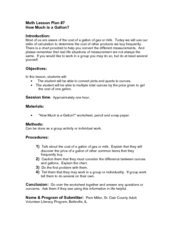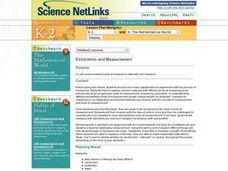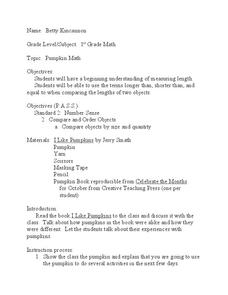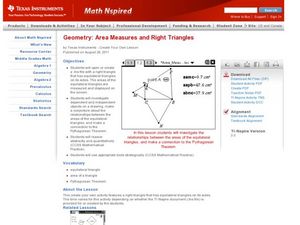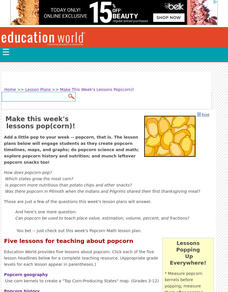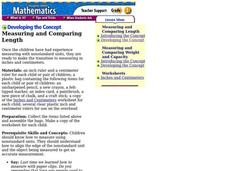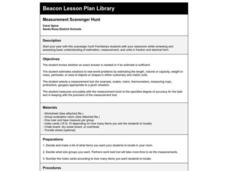Curated OER
Piecewise Linear Functions: Extending Stories to Graphs
Using this resource, scholars develop graphs that model situations by showing change over time. They answer 15 questions based on information from charts that show growth in weight. They extend the concepts to an assessment section of...
Curated OER
The Art of Interpreting Percent
Ddefine the relationships between fractions, decimals, and percentages in a series of lessons. The class practices converting between these three versions of a number. They also find the common factor of a numerator and denominator and...
CK-12 Foundation
Introduction to Mean, Median, and Mode: The Tree Conundrum
How many trees should we plant? Using an interactive as a manipulative, individuals find the mean, median, and mode for sets of data. They determine the number of trees to plant in each plot of land to reach a statistical goal.
Illustrative Mathematics
Latitude
The greater the latitude, the less of the Earth is north. Scholars graph the relationship between the latitude and the percentage of the Earth that is north of the latitude. Using the graph and the table, class members interpret values...
CK-12 Foundation
Complementary Angles
Here's an interactive that complements your lesson plans. Users of the resource adjust one of the angles in a complementary set to see how it affects the other. A set of challenge questions assesses understanding.
Curated OER
Algebra/Geometry Measurement
Fifth graders investigate units used to measure different geometric situations. In this geometry lesson plan, 5th graders measure length, mass, volume and temperature using units for measurements. They estimate the measurements before...
Curated OER
Whatcha Gunna Do When the Hulkster's Measuring Too??
Students measure using tools they have made. In this algebra lesson, students measure the height and distance using non-traditional measuring methods. They apply their findings to algebra and trigonometry properties of measurements.
Curated OER
Measuring Marvels
Students investigate measurement. In this library lesson plan, students discuss measurement, read Millions to Measure by David Schwartz, and complete a worksheet. Extra related activities are included in the lesson plan that appeals to...
Curated OER
Approximating Measures
Fourth graders complete a worksheet about approximate measurements. In this lesson on approximation, 4th graders compare the wingspan of a given bird to the wingspan of other birds and classroom objects.
Curated OER
You Can't Go Wrong with a Right Triangle 2
Upper graders use the properties of right angle trignonmetry to measure objects such as the school flagpole. They solve real world problems using these properties.
Curated OER
How Much Is A Gallon?
By engaging in real life examples, learners practice measurement and conversion skills. They review a chart comparing pints, quarts, and gallons. Then, they complete a worksheet involving prices per unit. For example, they calculate how...
Curated OER
Jr. Chef Club
Students examine the food pyramid. In this health/math lesson students make biscuits. Students are assigned a group to measure out ingredients. Students also discuss which part of the food pyramid biscuits fall into and the nutritional...
Curated OER
Measuring Angles
Middle schoolers explore angle measure as they estimate angle measure and measure and draw angles of less than 360 degrees. The lesson emphasizes the use of estimation when measuring angles.
Curated OER
Estimation and Measurement
Young scholars explore measurement and estimation with non-standard units. In this measurement lesson, students discuss items that could be used to measure; they use tooth picks to measure specific items around the classroom, both...
Curated OER
Measuring Angles & Segments
Young scholars view a PowerPoint for a warm-up lesson plan. They practice measuring around the classroom, measuring such things as the length and width of a desk, pencil, door, and book. Students use a website to practice measuring angles.
Curated OER
Gravity, Angles, and Measurement
Students relate math to real life scenarios. In this geometry lesson, students launch a ball tracking each launch using a graph. They analyze their data for speed, angles and distance, trying to improve on each launch.
Curated OER
Pumpkin Math
Young scholars discover how to measure the circumference of objects. In this measurement instructional activity, students use a pumpkin and a tape measure to estimate and find the circumference of the pumpkin.
Curated OER
Measuring Angles in a Quadrilateral
High schoolers explore quadrilaterals in this geometry instructional activity. They will draw a quadrilateral, measure the angles, and find the sum of the measures of the interior angles using Cabri Jr. The interactive capabilities of...
Curated OER
Area Measures and Right Triangles
Your class will investigate the relationship among different triangles. This geometry lesson, demonstrates how to make a connection between triangles and the Pythagorean Theorem. They identify the missing side or angle of a triangle.
Curated OER
Make This Week's Lessons Pop(corn)!
Students create popcorn timelines, maps, and graphs; do popcorn science and math; explore popcorn history and nutrition; and munch leftover popcorn snacks too!,
Curated OER
Measuring and Comparing Length
First graders use rulers to measure in both standard notation and centimeters. In this measuring lesson plan, 1st graders discuss the importance of a measuring standard. Students measure in inches and centimeters. Students compare inches...
Curated OER
Measuring Angles in a Triangle
High schoolers investigate the sum of the measures of the angles of a triangle. They draw a triangle and measure the interior angles. Using Cabri Jr., learners find the sum of the measures of the interior angles. The activity provides an...
Curated OER
Measurement Scavenger Hunt
Students review estimation, measurement, fractions, decimals while familiarizing themselves with a new classroom at the beginning of the year.
Curated OER
Measures of Central Tendency
Students analyze data using central tendencies. In this statistics lesson, students collect and analyze data using the mean, median and mode. They create a power point representing the different measures of central tendency.


